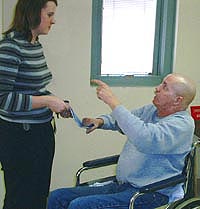Managing
Challenging Behaviors
 |
Changes in the brain in advanced
stages of HIV infection can produce behavioral changes that are challenging
to manage. Hyperactivity, impulsiveness, anger/agitation, manipulation
and general forgetfulness are among some of the behaviors persons with
HIV may exhibit. It is important to keep in mind that these behaviors
are generally not personal attacks against caregivers.
Disinhibition may occur along
with cognitive changes. The ability to distinguish inappropriate from
appropriate behavior is lost, and the person says or does whatever is
on his/her mind, lacking the awareness of how it is perceived by others.
For example, Monique reaches across the table and takes John's dessert
off the plate and proceeds to eat it without realizing that this is inappropriate.
Manipulative behaviors can
have an impact on caregivers. A client may ask several people the same
question not acknowledging the repetitiveness because of impaired memory.
In contrast, the client may purposefully engage in manipulative behaviors
by going from one person to the next in an attempt to have a desire fulfilled.
Misrepresenting what one staff member said may manipulate another staff
member to provide the desired effect. For example, some days John approaches
the social worker and asks for a cigarette after being told by the nurse
that he was not allowed to smoke at this time. John explains to the social
worker that the nurse said it was OK for him to smoke. He asks if the
social worker would give him a cigarette because the nurse is too busy. |
This graphic may help you determine
the influencing factors which may contribute toward behaviors that are difficult
to manage. After identifying "triggers" to certain behavior(s), strategies
can be implemented to modify and/or eliminate undesirable reactions.(Perez,
Proffitt, Calkins, 2001)

1. IDENTIFY THE PROBLEM
a. Terrel exhibits verbal outbursts of anger.
2. RECORD THE BEHAVIOR
a. Monitor the who, what, when, why of the situation.
b. Record on the tracking form the circumstances revolving around each episode
of behavior.
c. Try to find a pattern - Terrel displays agitated behaviors one hour after
breakfast.
3. LEARN ABOUT PREVIOUS HISTORY
a. Gather information from family about past patterns of behavior. - Terrel's
mother said the he was never a "morning person".
His best time of day was early evening.
4. ESTABLISH AN INTERVENTION
STRATEGY
a. Meet with the group of people responsible for Terrel's care.
5. PUT THE STRATEGY TO WORK
a. Decide which strategy will work the best, discuss the strategy with staff/caregivers,
and implement it.
b. Allow Terrel to lie down for 1 hour after breakfast and hold conversation
to a minimum.
6. RE-ASSESS
a. If your plan is not producing the desired outcome, begin the tracking process
again. Terrel still exhibits angry behaviors even after a rest in the morning.
The following is a behavior tracking
form to monitor and log each behavior that is being observed.
|
Behavior
Tracking Form |
| Behavior Being
Monitored: |
WHO
(Client's name) |
WHEN
(Time) |
WHERE
(Location where behavior occurred) |
WHAT
(Describe what the client is doing and the happenings in the surroundings) |
WHY
(What is your impression of the client's behavior) |
|
|
|
|
|
|
|
|
|
|
|
|
|
|
|
|
|
|
|
|
|
|
|
|
|
|
|
|
|
|
|
|
|
|
|
|
|
|
|
|
|
|
|
|
|
|
|
|
Other effective strategies
to help manage challenging behaviors:
- Develop a written contract
("This is what I expect from you and this is what I will provide to you").
Each party will sign it and adhere to it.
- Daily memory book (a
log of important care issues to refer to when needed).
- Help the individual
identify triggers that elicit undesirable behaviors.
Whether the behaviors are
a result of HIV infection, depression, mental illness, drug or alcohol abuse
or a reaction to medications, it is important to realize that individuals with
these issues may exhibit inappropriate behaviors directed toward caregivers
and others. Providing caregivers with insight into the nature of these behaviors
can provide effective coping strategies.

